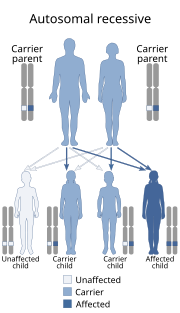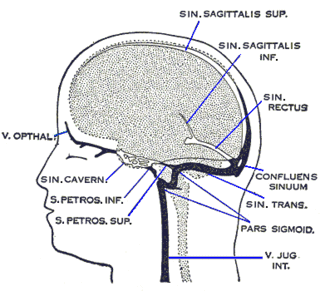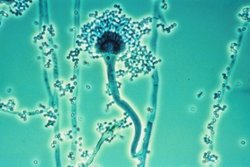
A granuloma is a structure formed during inflammation that is found in many diseases. It is a collection of immune cells known as macrophages. Granulomas form when the immune system attempts to wall off substances it perceives as foreign but is unable to eliminate. Such substances include infectious organisms including bacteria and fungi, as well as other materials such as keratin and suture fragments.

Chronic granulomatous disease (CGD) is a diverse group of hereditary diseases in which certain cells of the immune system have difficulty forming the reactive oxygen compounds used to kill certain ingested pathogens. This leads to the formation of granulomata in many organs. CGD affects about 1 in 200,000 people in the United States, with about 20 new cases diagnosed each year.

Rhinoscleroma, or simply scleroma, is a chronic granulomatous bacterial disease of the nose that can sometimes infect the upper respiratory tract. It most commonly affects the nasal cavity—the nose is involved in 95–100 per cent of cases—however, it can also affect the nasopharynx, larynx, trachea, and bronchi. Slightly more females than males are affected and patients are usually 10 to 30 years of age. Rhinoscleroma is considered a tropical disease and is mostly endemic to Africa and Central America, less common in the United States.

Ackerman syndrome is a familial syndrome of fused molar roots with a single canal (taurodontism), hypotrichosis, full upper lip without a cupid’s bow, thickened and wide philtrum, and occasional juvenile glaucoma. It was described by James L. Ackerman, A. Leon Ackerman, and A. Bernard Ackerman.

The cavernous sinus within the human head, is one of the dural venous sinuses creating a cavity called the lateral sellar compartment bordered by the temporal bone of the skull and the sphenoid bone, lateral to the sella turcica.
Perioral dermatitis is a type of skin rash. Symptoms include multiple small (1–2 mm) bumps and blisters sometimes with background redness and scale, localized to the skin around the mouth and nostrils. Less commonly the eyes and genitalia may be involved. It can be persistent or recurring and resembles particularly rosacea and to some extent acne and allergic dermatitis. The term dermatitis is a misnomer because this is not an eczematous process.

Fissured tongue is a benign condition characterized by deep grooves (fissures) in the dorsum of the tongue. Although these grooves may look unsettling, the condition is usually painless. Some individuals may complain of an associated burning sensation.

Melkersson–Rosenthal syndrome, is a rare neurological disorder characterized by recurring facial paralysis, swelling of the face and lips and the development of folds and furrows in the tongue. Onset is in childhood or early adolescence. After recurrent attacks, swelling may persist and increase, eventually becoming permanent. The lip may become hard, cracked, and fissured with a reddish-brown discoloration. The cause of Melkersson–Rosenthal syndrome is unknown, but there may be a genetic predisposition. It has been noted to be especially prevalent among certain ethnic groups in Bolivia. It can be symptomatic of Crohn's disease or sarcoidosis. Approximately 400 cases have been reported worldwide.
Balamuthia mandrillaris is a free-living amoeba that is known to cause the deadly neurological condition known as granulomatous amoebic encephalitis (GAE). B. mandrillaris is found in the soil and water and was first discovered in 1986 in the brain of a baboon that died in the San Diego Wild Animal Park. B. mandrillaris can infect the body through skin wounds or by inhaling the dust containing Balamuthia. Balamuthia has been isolated in nature. It is believed to be distributed throughout the temperate regions of the world. This is supported somewhat by the presence of antibodies to Balamuthia present in healthy individuals. The genus name Balamuthia was given by Govinda Visvesvara, in honor of his late mentor, the renowned parasitologist William Balamuth (1914–1981) for his contributions to the studies of parasitic and free-living amoebae. It was in 1993 when Visvesvara isolated and studied the pathogen for the first time.
Restylane is the trade name for a range of injectable fillers with a specific formulation of non-animal sourced hyaluronic acid (HA).
Orofacial granulomatosis (OFG) is a condition characterized by persistent enlargement of the soft tissues of the mouth, lips and the area around the mouth on the face. The enlargement does not cause any pain, but the best treatment and the prognosis are uncertain. The mechanism of the enlargement is granulomatous inflammation. The underlying cause of the condition is not completely understood, and there is disagreement as to how it relates to Crohn's disease and sarcoidosis.

Lupus miliaris disseminatus faciei (LMDF), also known as acne agminata, is a disease with a similar appearance to acne vulgaris. The cause of LMDF is unknown.

Periorbital dermatitis is a skin condition, a variant of perioral dermatitis, occurring on the lower eyelids and skin adjacent to the upper and lower eyelids.
Persistent edema of rosacea is a hard, nonpitting edema found on the areas involved, those mainly being the forehead, glabella, upper eyelids, nose, and/or cheeks.
Frontal Fibrosing Alopecia is the frontotemporal hairline recession and eyebrow loss in postmenopausal women that is associated with perifollicular erythema, especially along the hairline. It is considered to be a clinical variant of lichen planopilaris.
Granulomatous mastitis can be divided into idiopathic granulomatous mastitis and granulomatous mastitis occurring as a rare secondary complication of a great variety of other conditions such as tuberculosis and other infections, sarcoidosis and granulomatosis with polyangiitis. Special forms of granulomatous mastitis occur as complication of diabetes. Some cases are due to silicone injection or other foreign body reactions.
Granulomatous slack skin (GSS) is a rare cutaneous condition, a variant of lymphoma that typically presents in middle-aged adults.
Idiopathic facial aseptic granuloma is a cutaneous condition characterized by a chronic, painless, solitary nodule, reminiscent of an acne nodule, appearing on the cheeks of young children. It has a prolonged course, but spontaneously heals.
Formation of a granuloma is a common tissue response to a range of foreign bodies. Silicone can be directly injected into tissue as part of a cosmetic procedure or it can leak from silicone implants. The formation and consequences of silicon-induced granulomas is not well described or understood. The extent of damage that they cause is controversial.

Fungal sinusitis is the inflammation of the lining mucosa of the paranasal sinuses due to fungal infection. It occurs in people with reduced immunity. The maxillary sinus is the most commonly involved. Fungi responsible for fungal sinusitis are Aspergillus fumigatus (90%), Aspergillus flavus, and Aspergillus niger. Fungal sinusitis occurs most commonly in middle-aged populations. Diabetes mellitus is the most common risk factor involved.










